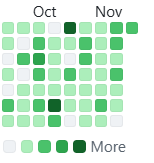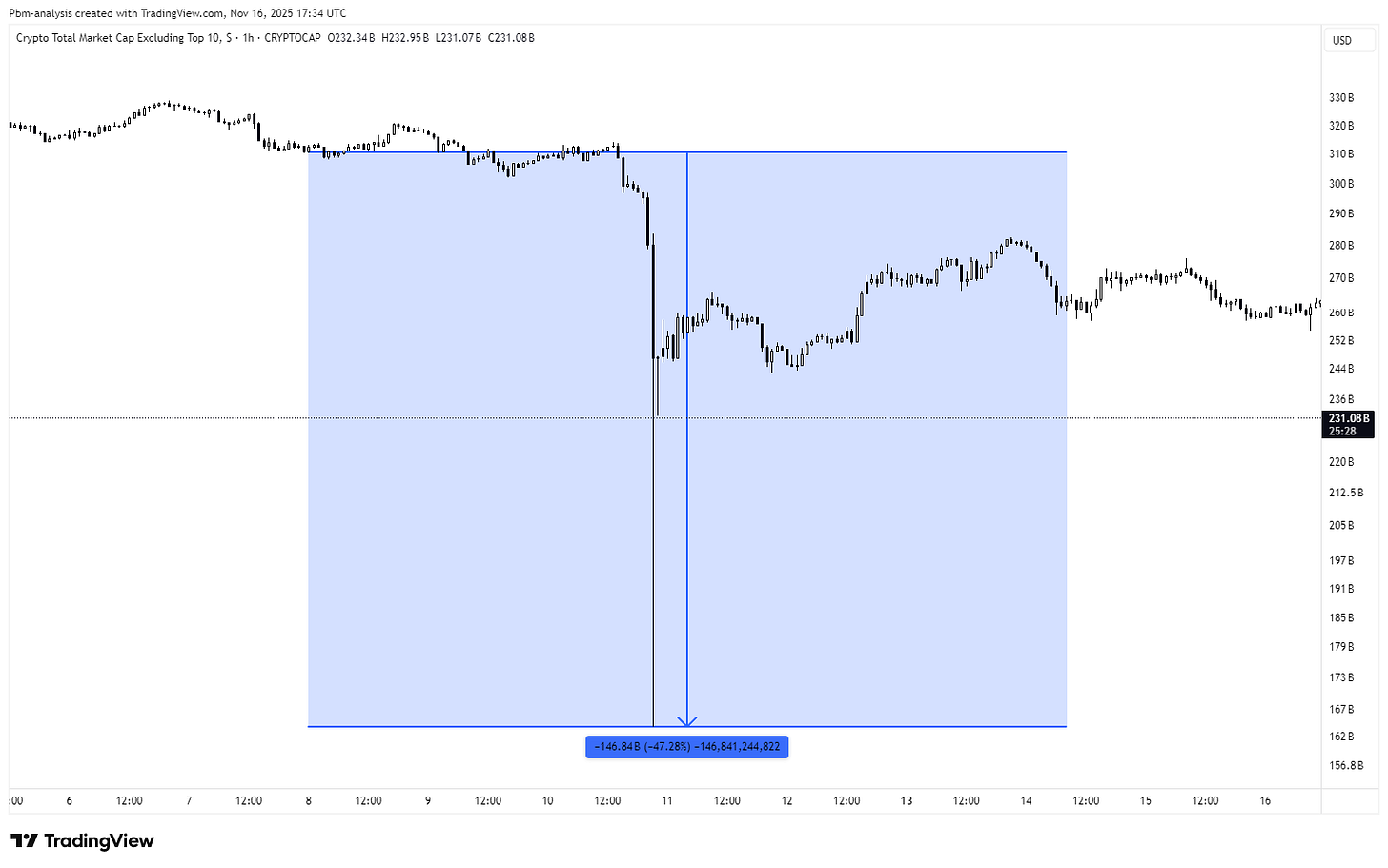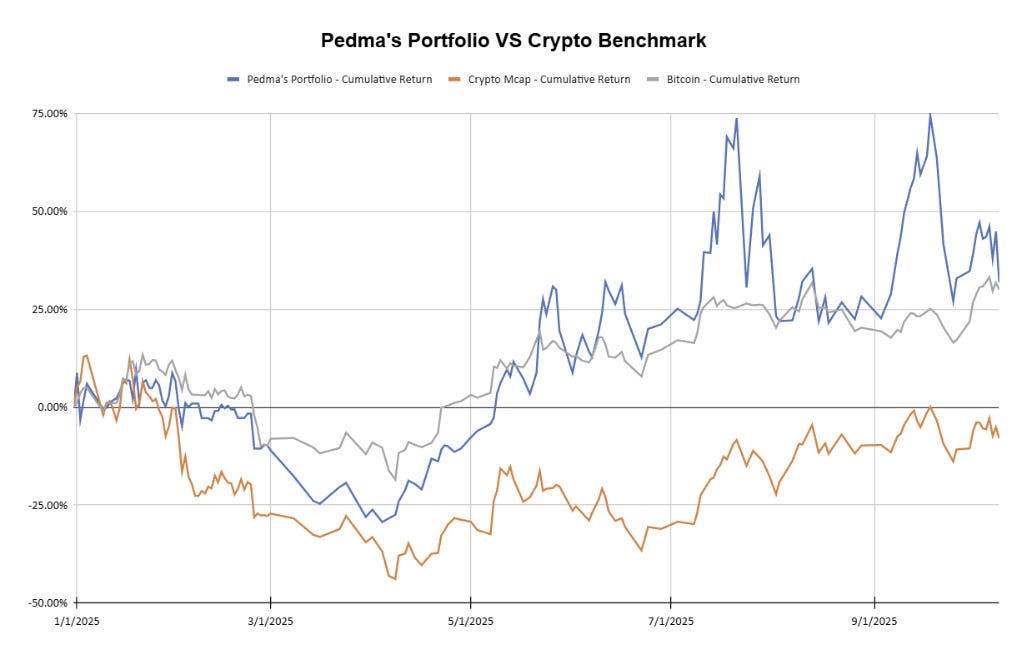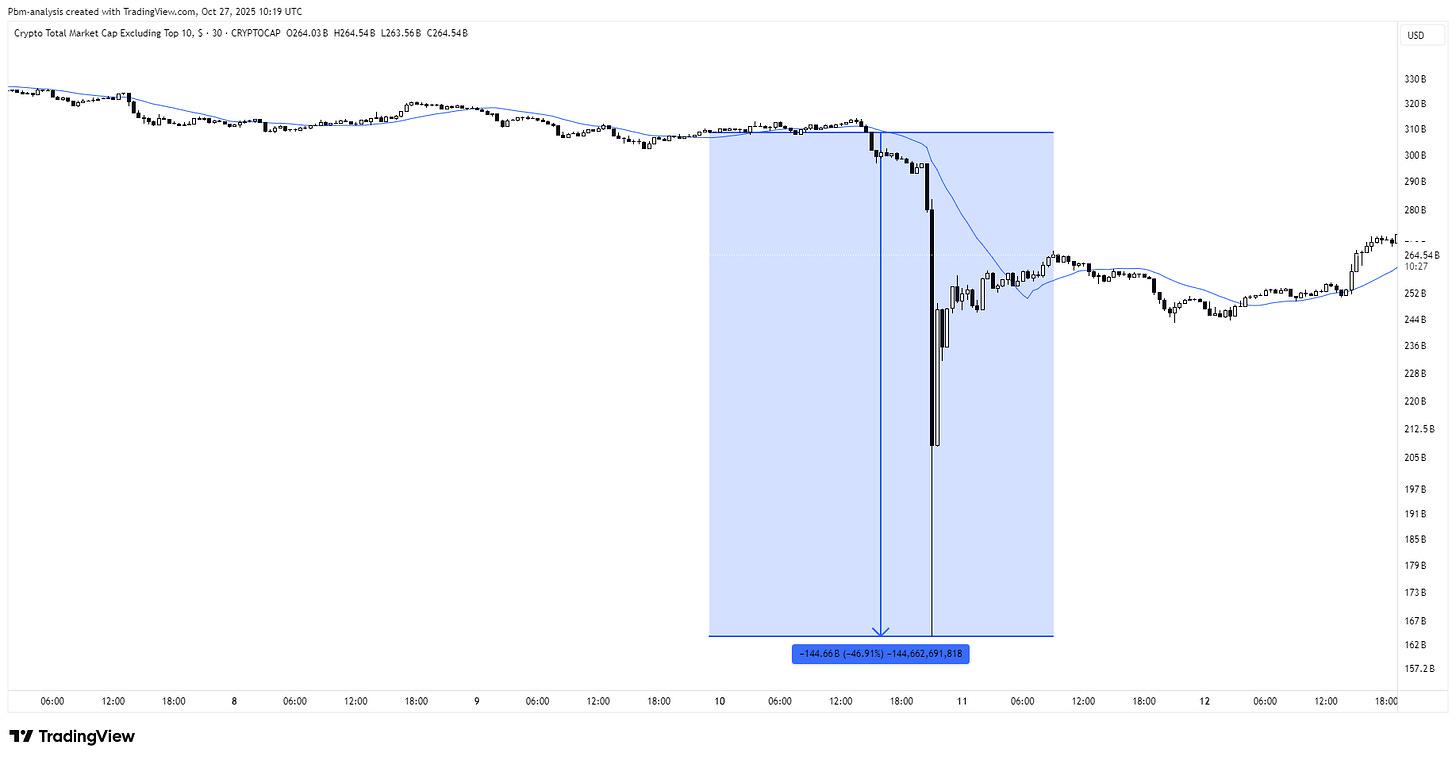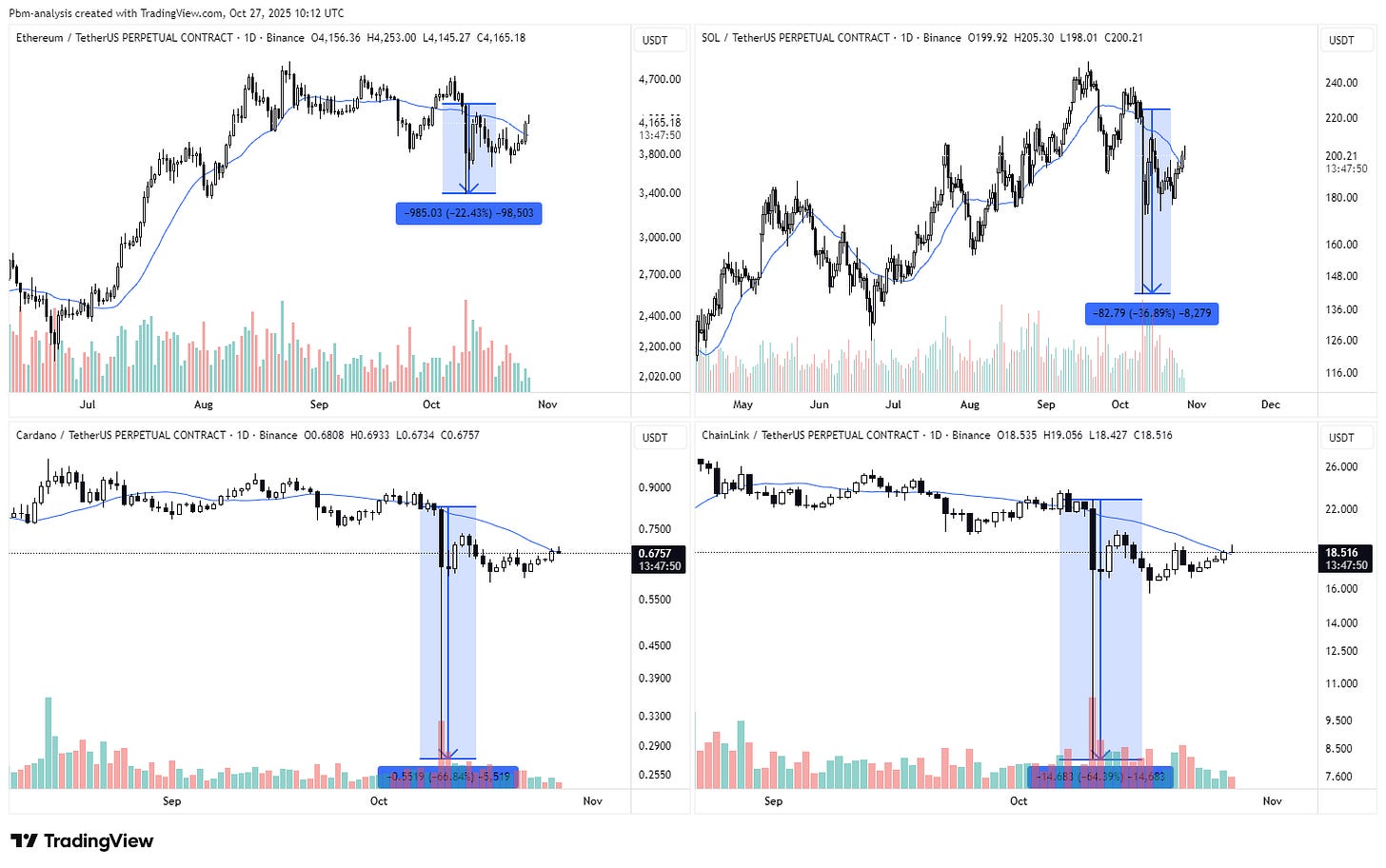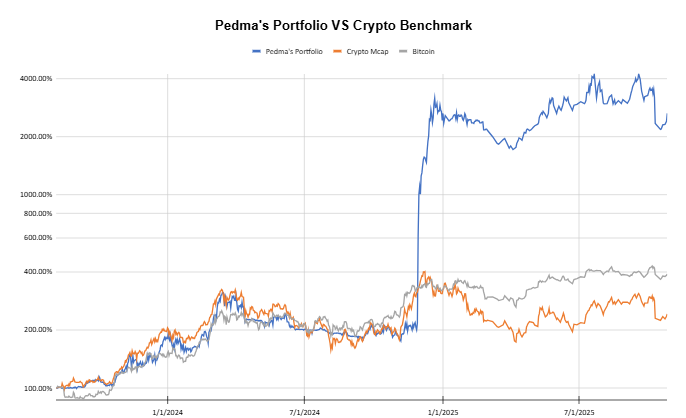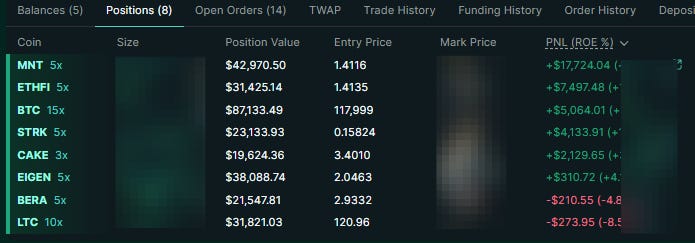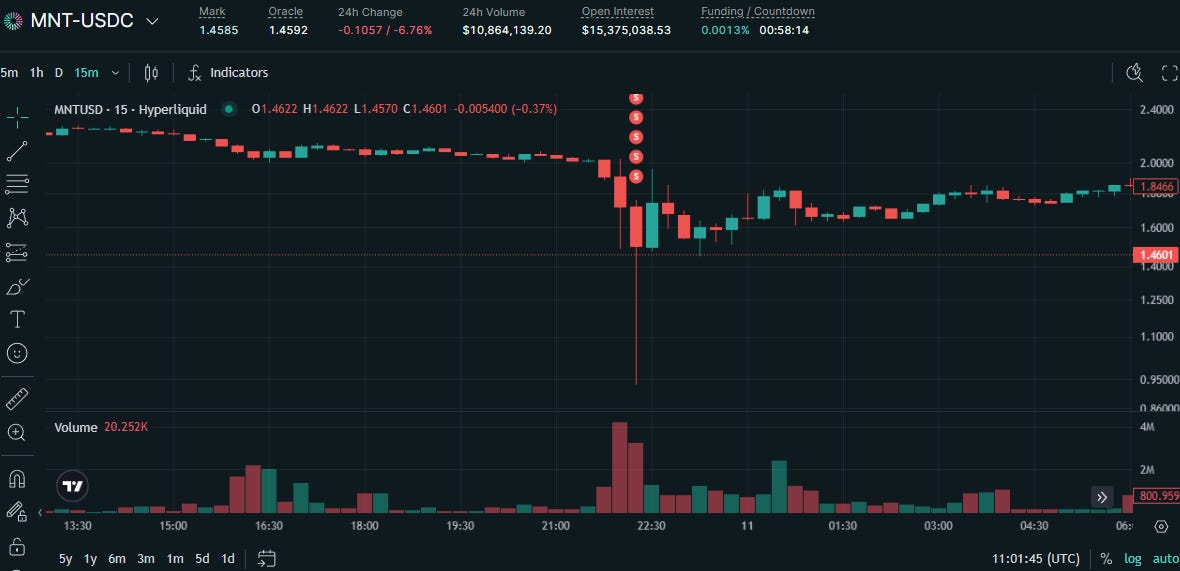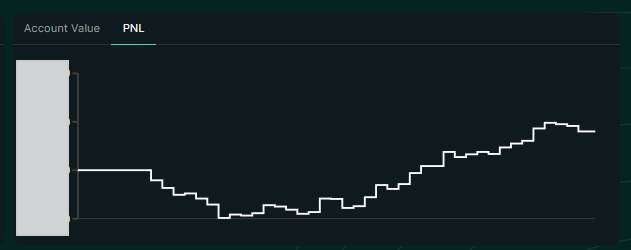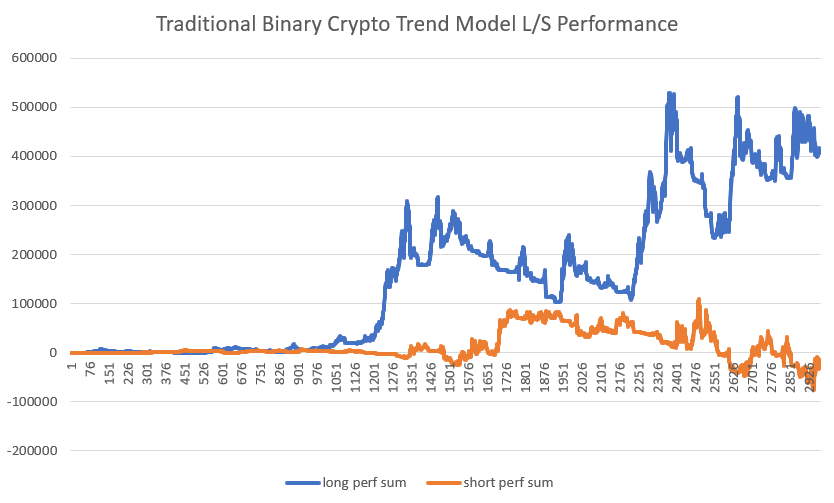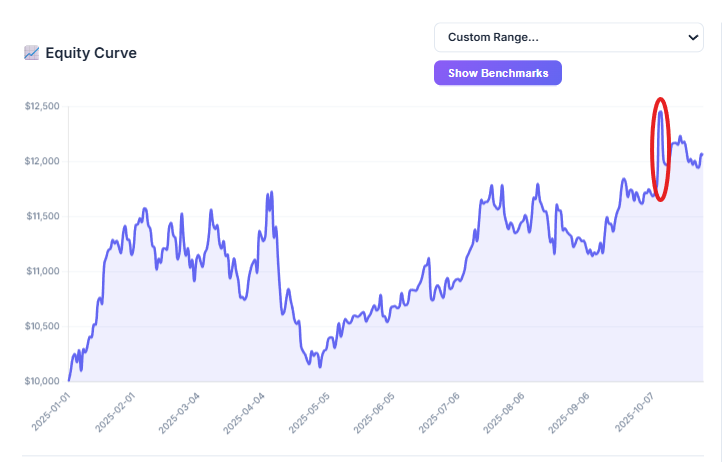What happened on 10/10/2025?
A day to remember.
Hey friends,
I haven’t posted in a while, but I haven’t forgotten about you. Every day I remind myself I have to write something useful here, and that has been bothering me.
This blog started off as a personal log of my own trading experiences. A place where I could log and document the path of becoming a self-sustainable trader. I want it to be more of that. I don’t want it to be just about long research articles and theoretical stuff. There’s a lot of people out there with far better academic capabilities than me.
Actual risk taking is what I do, and this last month, has been one of the best months in terms of getting my trading infrastructure to the next level.
I’ve been researching and deploying more models, with the purpose of achieving better performance under different regimes. The crypto world is not just trend following and there’s other things I can be doing on top of it—that I have realized.
But that’s a topic for another day.
Today I want to tell you about how I did on the 10th of October—the crypto flash crash.
If you don’t trade crypto, you may not be aware of it, so here’s a quick snapshot of the altcoins performance on that day. In the span of a few hours, the entire crypto market crashed ~50%, taking many out of the game, and leaving most traders with wounds that will take a long time to recover from.
How did my portfolio handle it? What mistakes did I do? What am I doing to fix them, so that they never happen again?
Well, that’s what I’ll get into in today’s post.
I hope that by sharing my experiences, you can avoid similar mistakes, and also forces me to “put in paper” both the mistakes I did, and what changes I am implementing going forward.
10th of October 2025
This day, is a day that I will never forget. It’s one of those days that is either defines your career, or ends it. It will be on the minds of every crypto trader/investor for a long time.
This year’s summer had been particularly difficult for traders that ran the same style of models that I did—trend with a net-long tilt. It was a very choppy summer. However, despite that, by September I was up over 60% ytd at the peak.
But as I said above, it was a very choppy summer, and I ended up going into a ~24% drawdown right before the 10th. I mean, that was normal to me, I expected it. So the day started off as a completely normal day—I was red on that day.
It was night already, I had probably half an hour before going to bed, and I was watching a show on my couch. I glance over at my phone and all is fine. I go back to watching the show, and was almost falling asleep.
Some time passes by, I open my tradingview app, and I see the altcoin index down over -30% and speeding. (now that I think about it, I do check twitter and tradingview perhaps a bit too much…)
That is insane… I think, as I refresh my app thinking it’s an error. Turns out, it wasn’t…
I jump off the couch and rush to the computer to find out what’s going on.
I had a few longs on the long-only trend portfolio, and some discretionary positions that also got closed out. Many of the longs were never meant to be closed out, but they got ADL’d (auto-deleveraging).
ADL is auto-deleveraging, a last resort back-stop mechanism of a crypto exchange to maintain solvency when standard liquidation mechanisms are exhausted. In very simple terms, if the platform can’t find enough liquidity to close bad (losing) positions, the ADL mechanism will forcefully reduce or close positions, even profitable ones, so that the platform doesn’t end up with bad debt.
But nothing compares to my hyperliquid exposure. As you know if you’ve read my performance updates, hyperliquid is a pretty significant exposure I hold, to the point that I think around 50% of my liquid net worth is composed of this one hold. Why do I have such an exposure as a systematic trader you may be wondering? Well… that’s another topic for another day.
But watching it take a 50% cut in just a few hours, is something I’ll never forget.
Imagine your entire net worth get cut in half in a few hours… Yeh, that happened.
The interesting thing to me is that, and I am being completely honest here, I felt nothing.
I was not scared, panicking, or had feelings that would’ve been completely warranted given the amount of exposure I had, and the volatility my entire portfolio was going through.
I was just numb to it. I accepted whatever fate it was stored for me even if this went all to 0. It’s a weird thing to say, but that’s the feeling I had on that day. Obviously I have safeguards, and even if crypto somehow collapsed and stuck there, I’d be fine. Even it did go to 0, I’d still be much better off than just a few years ago. I accepted that risk. I always knew there’s no excess return for free. I traded in the wild west of financial markets for a reason. I was net long for a reason. I was just getting handed that left tail risk I talked about for so long.
Anyways, I checked exchanges, most of them were broken, even those I had discretionary leveraged positions on. I could not close them. I could not even access the apps.
The major exchanges all had issues, there were no bids, and my positions got closed at the absolute worst levels due to ADL. Remember when I said I ran a long-only portfolio? Well, if you did that, you got pretty bad execution when the ADL hit them. If you were long/short, the shorts would’ve closed at the bottom of some of these wicks, but again, I wasn’t.
As I start refreshing the news, the liquidations numbers start pouring in. They’re just out of the charts. By the end of it all, over $20B of liquidations were reported. (The numbers are probably much higher as the major exchanges under-report these figures.)
To put it into perspective, the average move from open to low on that day was -63% across the board.
And we’re not just talking about some small caps on low liquidity. We’re talking about the multi-billion $ cryptocurrencies.
ETH, the second largest crypto asset by market capitalization, went down more than -20% in a few hours.
If we move a few steps lower on the market capitalization scale, and we go to linkchain for example, it went down -64% in a single session from its highs.
I survived it, but I was wounded. I still am. At the lowest point of the drawdown, I was down -48% from my equity peak. Granted, I was already on a 24% drawdown, but it was still massive.
Again, much of that drawdown is explained by my discretionary buy and hold of hyperliquid, but some of it was also derived from the net-long trend model. The market was already weak, so the long exposure wasn’t a lot, but it was enough to do damage. The largest unrealized gain on that day was MNT.
All of these positions, as I mentioned earlier in the post, were exited at very unfavorable prices due to the ADL mechanism of the exchange, which led to larger losses than what would’ve otherwise been expected.
As you can see below, a highly profitable position, got closed out almost at the bottom of the chart when the platform triggered the ADL.
This was one of my major lessons that we will get to later down the post.
On this MNT alone, at one point, I had over $20,000 unrealized, and by the end of it, I lost almost $7k on it due to the ADL.
I was at my desk until late that night processing all of this and refreshing X to see what was going on.
Eventually the market rebounded quite aggressively but the damage had been done—a nasty -26% hit to the portfolio on that day.
Still writing about it feels insane, but considering that I was up over 40x my portfolio from 2 years ago, you got to expect some tail events that will happen. Like we talk a lot about in here, it’s unreasonable to be in a market where the expected returns is so much higher than traditional, established markets, and at the same time, expect the security and safety of the latter.
However I am not trying to throw it under a rug also. I made mistakes, I had inefficiencies. I am fixing them so that next time we’re not going to be so exposed to it as we were then. We might be exposed to something else, but not this.
I always try to be brutally honest with myself. I’ve not done as well as I should’ve. That won’t happen again.
Let’s now get into lessons learned and what I am doing going forward.
Lessons Learned
1) Delta-neutral models look way more attractive than before
After the 10/10 debacle, I gained an increased appreciation for boring, market neutral models. They do look way more attractive to me, than they once were. I was once focused a lot more on absolute returns, and maximizing portfolio growth—that is changing. I am not saying that my book will shift 100% market neutral, but it will trend closer to that. I am at a capital stage that I can afford slower growth, for increased stability, while at the same time doing risky trades on the side. Not my entire book needs to be aggressive risk on. We can chill a bit.
I don’t want to over-romanticize it also, because like anything else, it carries its own risks and tradeoffs. The largest tradeoff being that when the market is hot, these sort of models will underperform in absolute returns compared to other models. Why? Because they’re supposed to have 0 net market exposure, and market carries a lot of performance doing those times. That means practically that when the market is going up, the short legs will carry a negative burden on the performance.
However during lengthy periods of market underperformance, like we’re going through right now, the performances are wildly superior to traditional models with net market exposure, for reasons I won’t get into in today’s post.
2) Being a good trader is a permanent state of research, improvement and iteration
This I knew already, but when you’re making money, you don’t care for it that much.
I’ve developed the long-only trend model in a rush during the summer of 2023 to get some exposure to the crypto market. I wrote a bit about it in this blog post in 12/2023:
At the time, I had a very naive notion of how these models work. Despite that, I am glad I launched it. It carried me forward for the next 2 years, instead of watching it from the sidelines. Whilst at the same time making decent returns during that period.
Had I stacked all my cash in the S&P500, as a standard example, I’d have half the growth that I got from this simple, rough model. Obviously the volatility is much higher, and the risks lurking underneath it, also are… but I didn’t care for that at the time, I cared about growth of the small portfolio I had.
However, let’s be real. It’s been a hard 2 years for this style of trading. We talked about it already a lot, but crypto trend has been really difficult to trade. If you put any trend trader doing the traditional stuff, you’ll see that their performances don’t differ from mine, at least directionally.
However, during this summer, I had already started branching out a lot. I’ve been exploring new models, that are not correlated to what I was doing before, but with the potential of offering diversification benefits to the portfolio. After all, I pay my bills with trading, and I am not constrained by the mandates that large funds are, so there’s no reason that I can’t go where they can’t.
One of these models that was under development was already deployed last week, and is doing its job during a tough market.
Now I am not saying I will be making money every day, week, or even month, but at least I will be adding uncorrelated sources of return, with the goal of smoothing my portfolio growth over time.
One of the main reasons I made money last year was due to my discretionary bets on hype, pump, the “taco” trade whenever Trump nuked the market, idiosyncratic plays that happened here and there, farming protocol airdrops, etc. Many of these are not yet realized, but I have significant airdrops coming up in 2026 due to all of this work.
All of these were and are major contributors to PnL, and that showed me that there’s a path forward that is not only reliant on general market beta, even though a portion of the portfolio can be.
There’s tons of opportunities in crypto for pure alpha. I can compete in there and I will.
3) Short-side is insurance you pay
In traditional trend-following models, the short side tends to not make as much money as the long side. In many cases, it actually loses money over the long haul.
A trader could look at it and think about removing it from their portfolio. Why add a negative burden to the performance, just keep the money maker on right?
Well, if he traded through the 10/10, he’d have found out why it was there. It’s almost as insurance that you pay for each month, but when a black swan event happens, or markets simply collapse, it’s there to help absorb the blow.
Consider the example below. On a long-only trend model, on the 10/10/2025, the model experienced a -16% hit in a single day.
However if we test a simple long/short trend model, it would’ve not only protected the portfolio, but also provide a quite decent return on that day.
(obviously ADL is hard to simulate for because it’s dependent on liquidity at that time on the exchange, but many of the positions on the short side would’ve been closed out near the bottom of the wicks, which is far better than the backtested assumptions…)
So once again, reinforcing the idea that shorts add a necessary market protection, that I will be glad to pay for going forward.
3) Time to press the gas and when not to
Publicly I always say that traders should keep their risk constant, because they tend to overestimate their ability to size positions appropriately, to their perceived edge.
But privately, and in my trading friends group, I am not always 100% adhering to that rule.
There’s times in the market, that when you have some experience, you can see that its time to press size because it’s the most favorable time to do so. But that takes a lot of experience.
Now, I am not saying that I’d increase the risk of my models depending on how I felt about the market. I think that’s a pretty bad precedent. I leave systematic models to be systematic. However, I do carry a portion of my portfolio where I can swing for the fences, let’s say. A portion that if I lost, wouldn’t break me, but enough to scratch that itch when I see an almost too good of an opportunity to pass.
I’ve done that a lot this year, and it served me well.
I wouldn’t advise it to traders starting out, that don’t understand the game yet, and even less playing around with exponential betting size. But there comes a time, that you’re here every day, for years on end, that you can almost sense things that others can’t. And that is something I am taking more advantage off.
Conclusion
The 10/10 showed me risks and flaws I carried, that were hidden away underneath good performance, for far too long. When you get lazy in a high performance field, you will pay the cost for that, eventually. I paid it, and it could’ve been much lower had I stopped to think about it for a second. That won’t happen again.
Many people lost their entire portfolios in that day. More people than we realize because not everyone admits it. I was wounded, but not fatal. I am still here and a bit wiser for it.
This is how we learn. To be exposed to the game, to take the losses and confront them head on. Trading is a pure meritocratic endeavor. You either perform or you don’t, and your PnL reflects that. There’s no way around it, no office politics to carry you, no charisma, nothing. You either improve, or you get left behind.
It’s a ruthless game, but a game I love to play.
Disclaimer: The content and information provided by the Trading Research Hub, including all other materials, are for educational and informational purposes only and should not be considered financial advice or a recommendation to buy or sell any type of security or investment. Always conduct your own research and consult with a licensed financial professional before making any investment decisions. Trading and investing can involve significant risk of loss, and you should understand these risks before making any financial decisions.


